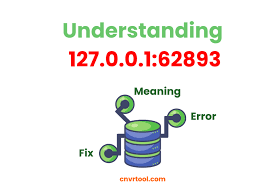Your Guide to Fixing 127.0.0.1:62893 Errors

In the realm of networking and local server development, encountering errors related to 127.0.0.1:62893 can be a common yet perplexing issue. This guide aims to clarify what these errors mean and provide step-by-step solutions to resolve them. Whether you're a developer working on a local application or a system administrator troubleshooting network issues, understanding and addressing these errors is crucial for maintaining smooth operations.
Understanding 127.0.0.1:62893
To tackle 127.0.0.1:62893 errors effectively, we first need to understand what this notation represents:
- 127.0.0.1: This is the loopback IP address, commonly referred to as localhost. It is used by a computer to refer to itself. When you access 127.0.0.1, you're effectively accessing services running on your own machine.
- 62893: This is a port number. Ports are used by the operating system to differentiate between different services or applications running on the same IP address. Port numbers range from 0 to 65535, with the range from 49152 to 65535 reserved for dynamic or private use.
When you see an error related to 127.0.0.1:62893, it typically involves an issue with a local service or application that is supposed to communicate over this port.
Common Causes of 127.0.0.1:62893 Errors
- Service Not Running: The most common issue is that the service you’re trying to reach on port 62893 is not running. This could be due to the service crashing, not starting up correctly, or not being configured to listen on the specified port.
- Port Conflict: Another possibility is a port conflict. If another application or service is already using port 62893, your service may fail to start or bind to the port.
- Firewall or Security Software: Sometimes, firewall or security software can block access to certain ports, including 62893. This can prevent your application from communicating as expected.
- Incorrect Configuration: The service or application might be incorrectly configured to use the wrong port, or there might be a typo in the configuration files.
- Network Issues: While less common for local 127.0.0.1 issues, network configurations or software settings might interfere with the expected behavior.
Troubleshooting Steps
1. Check Service Status
Ensure that the service you are trying to access is running. Here’s how you can check and restart it:
- Windows: Open the Task Manager (Ctrl + Shift + Esc), go to the "Services" tab, and look for your service. You can restart it by right-clicking and selecting "Restart."
- Linux/Mac: Use commands like ps aux | grep <service-name> to find if the service is running. Restart it using appropriate commands, such as sudo systemctl restart <service-name> or sudo service <service-name> restart.
2. Verify Port Availability
Check if the port 62893 is being used by another process:
- Windows: Open Command Prompt and use netstat -a -n -o | findstr :62893 to see if the port is in use. If it is, you can identify the process using the port and decide whether to terminate it or change your service’s port.
- Linux/Mac: Use netstat -an | grep 62893 or lsof -i :62893 to check for port usage.
If a port conflict is found, either stop the conflicting service or configure your service to use a different port.
3. Adjust Firewall and Security Settings
Make sure your firewall or security software isn’t blocking port 62893:
- Windows Firewall: Go to Control Panel > System and Security > Windows Defender Firewall > Advanced settings. Add a new inbound rule to allow traffic on port 62893.
- Linux/Mac: Use iptables or ufw commands to adjust firewall settings. For example, sudo ufw allow 62893/tcp allows TCP traffic on port 62893.
4. Review Configuration Files
Check the configuration files for your service to ensure that it is set to use the correct port. Common files to check include config.json, .env files, or service-specific configuration files.
Ensure there are no typographical errors and that the port number matches what your service is supposed to use.
5. Examine Logs and Error Messages
Look at the logs for your service to identify any specific error messages related to the port issue. Logs often provide insight into what might be going wrong and can direct you to a more specific solution.
6. Restart Your System
As a last resort, restarting your system can sometimes resolve issues related to ports and services. This can clear temporary issues and reset configurations.
Preventive Measures
To avoid encountering 127.0.0.1:62893 errors in the future:
- Regular Monitoring: Keep an eye on the services running on your machine and their port usage.
- Update Software: Ensure that both your operating system and the software you are using are up-to-date, as updates often include bug fixes and improvements.
- Use Configuration Management Tools: For more complex setups, consider using configuration management tools like Ansible or Docker, which can help manage and standardize service configurations.
- Document Your Configurations: Maintain good documentation of your service configurations, including port numbers and any specific setup details.
Conclusion
Dealing with 127.0.0.1:62893 errors requires a systematic approach to identify and resolve the underlying issues. By understanding the role of the loopback address and port number, and following the troubleshooting steps outlined above, you can address these errors effectively. Whether it’s ensuring that your service is running, verifying port availability, adjusting firewall settings, or reviewing configuration files, these steps will help you maintain a smooth and functional local development environment.
- Art
- Causes
- Best Offers
- Crafts
- Dance
- Drinks
- Film
- Fitness
- Food
- Jogos
- Festival
- Gardening
- Health
- Início
- Literature
- Music
- Networking
- Outro
- Party
- Religion
- Shopping
- Sports
- Theater
- Wellness



